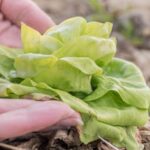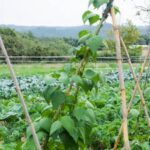Vegetable gardening in the Midwest brings numerous benefits, from enjoying fresh produce to saving money and promoting environmental sustainability. The University of Illinois Extension recognizes the importance of vegetable gardening and is committed to providing reliable information and resources for gardeners across the region.
When we grow our own vegetables, we have access to a wide variety of fresh and nutritious produce right in our backyard. Not only does this enhance the flavor of our meals, but it also ensures that we are getting the maximum nutritional value from our food.
Additionally, vegetable gardening can be a cost-effective alternative to buying produce at the grocery store. By investing time and effort into cultivating your own vegetables, you can significantly reduce your grocery bills while reaping the rewards of your labor.
In addition to personal benefits, vegetable gardening in the Midwest also contributes to environmental sustainability. By growing your own food, you have control over what pesticides or fertilizers are used, supporting organic practices that promote healthy soil and minimize harm to beneficial insects and wildlife. Furthermore, reducing food miles by growing your vegetables locally helps minimize carbon emissions associated with long-distance transport.
The University of Illinois Extension understands the importance of vegetable gardening in enhancing food security, improving health outcomes, and fostering sustainable communities in the Midwest. With their expertise and dedication, they provide invaluable gardening resources and information tailored specifically for Midwest gardeners.
Whether you are a beginner or an experienced gardener, their guidance can help you achieve successful yields while promoting environmental stewardship. So let’s dive into understanding how you can make the most out of vegetable gardening in this unique region.
Understanding the Midwest Climate and Soil for Vegetable Gardening
The climate and soil conditions in the Midwest pose both challenges and advantages for vegetable gardening. By understanding these factors, gardeners can adapt their practices to ensure successful growth and a bountiful harvest.
Unique Challenges of Midwest Gardening
One of the primary challenges of gardening in the Midwest is the temperature fluctuations. The region experiences hot summers and cold winters, which can impact the growth and development of vegetables. It is important for gardeners to select varieties that are well-suited to these extreme temperature changes and provide optimal growing conditions.
Tips for Assessing and Preparing Soil
Another crucial aspect of vegetable gardening in the Midwest is soil composition. The region’s soil tends to be heavy clay or sandy, both of which present their own challenges. Before planting, it is essential to assess the condition of the soil and make any necessary improvements.
To assess soil quality, gardeners can perform a simple test by taking a handful of soil and squeezing it tightly. If it crumbles when released, it has good texture; if it forms a compact ball, it could indicate heavy clay or compaction issues.
Improving soil structure can be done through the addition of organic matter such as compost or well-rotted manure. This helps to loosen compacted soil, improve drainage, and add valuable nutrients that promote healthy plant growth.
Furthermore, testing the pH level of the soil is recommended as different vegetables thrive in specific pH ranges. A pH test kit can be purchased at garden centers or through the University of Illinois Extension.
By understanding the unique nature of Midwest climate and properly preparing the soil, vegetable gardeners can set themselves up for success. The next step is selecting suitable vegetables for this region’s conditions; an area that will be explored in great detail in Section 3.
Selecting the Right Vegetables for Midwest Gardens
When it comes to vegetable gardening in the Midwest, selecting the right vegetables is crucial for a successful and fruitful garden. Fortunately, the University of Illinois Extension has provided a list of recommended vegetables specifically tailored for Midwest gardens. These recommendations take into consideration factors such as hardiness and suitability to the region’s climate, ensuring that your garden thrives even in challenging conditions.
One important factor to consider when selecting vegetables for your Midwest garden is their ability to withstand fluctuations in temperature. The Midwest climate can be quite unpredictable, with hot summers and cold winters. The University of Illinois Extension recommends choosing vegetables that are known for their tolerance to these temperature extremes. Some examples include tomatoes, bell peppers, zucchini, carrots, and leafy greens like kale and spinach.
Another essential aspect to consider is the suitability of vegetables to the soil composition commonly found in the Midwest. Soil in this region tends to be heavy clay or loamy with a high organic matter content. To make the most of your vegetable garden, it is important to select varieties that thrive in these soil types. For example, root crops like potatoes and radishes perform well in clayey soils due to their ability to break through dense soil particles.
Additionally, considering native or adapted vegetable varieties is beneficial for Midwest gardens. These varieties have been specifically bred or crossbred over generations to be better adapted to local climatic conditions and pests commonly found in the region. By selecting these varieties recommended by the University of Illinois Extension, you can increase your chances of achieving higher yields while reducing pest-related issues.
Planning and Designing Your Midwest Vegetable Garden
Proper planning and design are essential for a successful vegetable garden in the Midwest. Taking the time to carefully consider factors such as sunlight exposure, water supply, and spacing between plants can greatly increase your chances of a bountiful harvest. In this section, we will discuss the importance of garden layout and offer tips on how to plan and design your Midwest vegetable garden.
When planning your vegetable garden, one of the first things to consider is sunlight exposure. Most vegetables thrive in full sun, which is defined as at least six hours of direct sunlight per day. Take note of where shadows fall throughout the day and plan accordingly. Orienting your garden beds from north to south can help maximize sunlight exposure for all plants.
Water supply is another crucial factor to consider when planning your vegetable garden. Vegetables generally require about 1 inch of water per week, either from rainfall or irrigation. It is important to have a reliable source of water nearby, whether that be through a hose or an installed irrigation system. Keep in mind that certain vegetables may have different watering requirements, so it is helpful to group plants with similar needs together.
Spacing between plants is also key to ensure healthy growth and prevent overcrowding. Each vegetable has specific spacing requirements, which should be followed for optimal results. Proper spacing allows for good air circulation, reducing the risk of diseases and pests. Additionally, it allows each plant to access sufficient nutrients and resources from the soil.
| Frequently Asked Questions | Answers |
|---|---|
| How much space should I allocate for my vegetable garden? | Size depends on personal preference; start small if you’re new to gardening. |
| Are there any plants that benefit from being planted together? | Companion planting can help deter pests and enhance growth for certain vegetables; research companion planting combinations for beneficial pairings. |
| How do I make the most of limited space in my garden? | Utilize vertical gardening techniques such as trellises or containers to maximize space. |
By carefully planning and designing your Midwest vegetable garden, you are setting yourself up for a successful growing season. Take the time to assess sunlight exposure, water supply, and spacing between plants to create an optimal environment for your vegetables. Remember that proper planning now will lead to a more enjoyable and productive gardening experience later on.
Essential Tools and Supplies for Midwest Vegetable Gardening
Tools for Midwest Vegetable Gardening
Having the right tools can make all the difference when it comes to successful vegetable gardening in the Midwest. Here are some essential tools recommended by the University of Illinois Extension:
- Hand trowel: A hand trowel is a versatile tool that can be used for digging small holes, transplanting seedlings, and weeding.
- Garden fork: A garden fork is useful for loosening compacted soil and turning over garden beds. It helps improve soil structure and allows better drainage.
- Pruning shears: Pruning shears are essential for trimming and shaping plants, as well as cutting off dead or diseased branches.
- Garden hoe: A garden hoe is great for removing weeds and breaking up soils in larger areas. Choose one with a sharp blade for maximum efficiency.
- Garden rake: A garden rake is used for leveling soil, removing stones, and breaking up clumps after tilling or planting.
- Watering can or hose: Adequate watering is crucial for healthy vegetables. Choose a watering can with a long spout or a hose attachment to ensure even distribution of water.
- Wheelbarrow or garden cart: These tools are invaluable for transporting soil, compost, plants, and other heavy items around your garden.
Supplies for Midwest Vegetable Gardening
In addition to tools, there are several supplies that will help ensure a successful vegetable garden:
- Seeds or seedlings: Depending on your preference, you can start your plants from seeds or purchase young seedlings from local nurseries or garden centers.
- Fertilizer: Vegetables require regular feeding to promote healthy growth and high yields. Choose a balanced fertilizer specifically formulated for vegetables and follow the instructions on the packaging.
- Mulch: Mulching is important in the Midwest to conserve moisture, suppress weed growth, and regulate soil temperature. Organic mulches like straw, grass clippings, or shredded leaves are best.
- Plant supports: Many vegetable plants benefit from support to keep them upright as they grow. Options include trellises for climbing plants like tomatoes or cucumbers, and stakes or cages for plants like peppers.
- Garden labels: Keeping track of what you planted where is essential for proper care and maintenance. Use garden labels or markers to identify different varieties and their planting locations.
- Protective equipment: Depending on the specific pests in your area, you may need supplies such as row covers, netting, or organic insecticides to protect your vegetables from damage.
Remember that investing in quality tools and supplies can save you time and effort in the long run while promoting healthy plant growth and successful harvests. The University of Illinois Extension also offers additional recommendations specific to your region’s climate and growing conditions, so be sure to check their resources for more detailed information.
Establishing and Maintaining Healthy Soil in Midwest Vegetable Gardens
One of the key factors for successful vegetable gardening in the Midwest is the establishment and maintenance of healthy soil. Healthy soil provides essential nutrients, aids in moisture retention, and promotes good drainage. It supports strong root systems and helps plants withstand environmental stresses, pests, and diseases. The University of Illinois Extension offers valuable recommendations for maintaining healthy soil in Midwest vegetable gardens.
Soil amendment is an important practice to improve the quality of soil. Adding organic matter such as compost or well-rotted manure can enhance the soil’s structure, increase its ability to retain moisture, and provide essential nutrients to plants. According to the University of Illinois Extension, adding 2-4 inches of organic matter each year is beneficial for vegetable gardens.
Composting is another effective way to improve soil health. Compost is a rich source of organic matter that adds nutrients to the soil and helps maintain a balanced pH level. It also enhances water holding capacity and promotes beneficial microbial activity in the soil. The University of Illinois Extension recommends creating a compost pile using kitchen scraps, yard waste, leaves, and grass clippings.
Mulching is a helpful practice to conserve moisture in the soil and prevent weed growth. Organic mulches like straw or shredded leaves can be applied around vegetables after planting to retain moisture, regulate temperature fluctuations, suppress weeds, and protect against erosion. The University of Illinois Extension suggests applying a layer of mulch about 2-4 inches thick around plants once they are established.
Overall, establishing and maintaining healthy soil is crucial for successful vegetable gardening in the Midwest. By following practices recommended by the University of Illinois Extension such as soil amendment, composting, and mulching, gardeners can create an environment that nurtures vigorous growth and robust yields.
| Soil Improvement Practices | University Recommendations |
|---|---|
| Soil Amendment | The University of Illinois Extension recommends adding 2-4 inches of organic matter, such as compost or well-rotted manure, to improve soil structure and nutrient content. |
| Composting | The University of Illinois Extension recommends creating a compost pile using kitchen scraps, yard waste, leaves, and grass clippings to enhance soil fertility and microbial activity. |
| Mulching | The University of Illinois Extension advises applying a layer of organic mulch around plants to conserve moisture, suppress weeds, and protect against erosion. |
Pest and Disease Management in Midwest Vegetable Gardens
Maintaining a healthy and productive vegetable garden in the Midwest involves dealing with various pests and diseases that can impact plant growth. The University of Illinois Extension offers valuable tips and recommendations for effective pest and disease management to ensure the success of your garden.
- Prevention: The first line of defense against pests and diseases is prevention. Implementing proper sanitation practices, such as removing dead or diseased plants promptly, can help prevent the spread of pathogens. Additionally, practicing crop rotation can reduce the likelihood of recurring pest infestations and diseases. By rotating your vegetable crops each year, you disrupt pest life cycles and limit the buildup of soil-borne diseases.
- Identification: It is crucial to accurately identify pests or diseases affecting your vegetables in order to apply appropriate control measures. The University of Illinois Extension provides resources, such as plant clinics and diagnostic labs, where you can submit samples for identification. They also offer guides and publications to help you recognize common pest insects, diseases, and nutrient deficiencies.
- Integrated Pest Management (IPM): Adopting an IPM approach involves using a combination of cultural, biological, mechanical, and chemical control methods to manage pests effectively while minimizing environmental impact. The University of Illinois Extension recommends starting with cultural practices like planting resistant varieties, providing adequate nutrition and water for plants, and promoting beneficial insects that prey on pests.
If further intervention is needed, they provide information on safe insecticides or fungicides that are approved for use in vegetable gardens. - Organic Pest Control: For those who prefer organic gardening methods, the University of Illinois Extension also offers guidance on natural alternatives for pest management. These include introducing beneficial insects like ladybugs or lacewings that prey on harmful bugs or using organic sprays made from ingredients like neem oil or soap solutions.
- Disease Management: Proper disease management is essential to keep your vegetable plants healthy and productive. The University of Illinois Extension advises avoiding overhead watering, as moisture on the leaves can promote disease development. They also recommend using disease-resistant plant varieties, practicing crop rotation, and applying appropriate fungicides if necessary.
By following these pest and disease management tips from the University of Illinois Extension, you can protect your Midwest vegetable garden from common threats and enjoy a thriving harvest. Remember to stay vigilant in monitoring your plants for any signs of pests or diseases and take immediate action to prevent further damage.
The University of Illinois Extension’s website provides detailed information on specific pests, diseases, and organic solutions to help you address any issues that may arise in your garden.
Harvesting and Preserving Your Midwest Vegetable Garden Bounty
Once your Midwest vegetable garden has flourished and produced a bountiful harvest, it is important to know how and when to harvest your vegetables for optimal flavor and nutrition. The University of Illinois Extension offers valuable tips and techniques to help you make the most of your garden bounty.
Timing is crucial when it comes to harvesting vegetables in the Midwest. Each vegetable has its own specific maturity indicators, so it is essential to know when they are at their peak ripeness. For example, tomatoes should be harvested when they are firm and fully colored, while cucumbers are best picked when they are smaller in size and still tender. Be sure to check the recommended harvesting time for each of your vegetables to maximize their taste and texture.
Once you have harvested your vegetables, it’s important to promptly store or preserve them to maintain their quality. Freezing is an excellent option for preserving many types of vegetables. Blanching them quickly before freezing helps retain their color, flavor, and nutrients.
The University of Illinois Extension recommends blanching vegetables by submerging them briefly in boiling water, followed by immersing them in ice water to stop the cooking process. After blanching, drain the vegetables well before packing them into freezer-safe containers or bags.
Canning is another popular method for preserving Midwest vegetable garden produce. This involves using heat processing to kill bacteria and other microorganisms that can cause spoilage. The University of Illinois Extension provides step-by-step instructions on safe canning practices on their website, ensuring that your canned goods remain safe for consumption over an extended period.
Pickling is yet another way to preserve those extra cucumbers or green beans from your garden. By soaking the vegetables in a brine made with vinegar, salt, sugar, and spices, you can create flavorful pickles that can be enjoyed months later as crunchy snacks or condiments.
Preserving your Midwest vegetable garden bounty allows you to enjoy the fruits of your labor long after the growing season has ended. Whether you choose freezing, canning, or pickling, the University of Illinois Extension offers detailed instructions and guidelines to ensure safe and successful preservation. Don’t let any of your hard-earned vegetables go to waste – explore the University of Illinois Extension’s resources and start preserving your harvest today.
Conclusion
In conclusion, vegetable gardening in the Midwest offers numerous benefits, including access to fresh produce, cost savings, and environmental sustainability. With its unique climate and soil conditions, however, gardening in this region can present some challenges. Fortunately, the University of Illinois Extension is here to provide reliable information and resources to help gardeners navigate these challenges and achieve successful vegetable gardens.
Throughout this article, we have explored various aspects of vegetable gardening in the Midwest, from understanding the climate and soil composition to selecting the right vegetables and designing a productive garden layout. We have also discussed essential tools and supplies, establishing healthy soil practices, pest and disease management strategies, as well as techniques for harvesting and preserving your vegetable bounty.
The University of Illinois Extension has been a valuable source of recommendations and tips for all stages of the gardening process. Their expertise in Midwest gardening combined with their dedication to research-based information makes them an invaluable resource for gardeners in this region. Whether you are a beginner or an experienced gardener, I encourage you to explore their website for further guidance on vegetable gardening in the Midwest.
By utilizing the knowledge and resources provided by the University of Illinois Extension, you can enhance your gardening skills and enjoy a bountiful harvest year after year. So grab your tools, prepare your soil accordingly, select appropriate vegetables for your region, plan your garden layout efficiently while considering sunlight exposure and spacing between plants. With these steps and the guidance from the University of Illinois Extension, you’ll be on your way to successful vegetable gardening in the Midwest.
Frequently Asked Questions
What is the vegetable garden Act in Illinois?
The Vegetable Garden Act in Illinois is a legislation that was passed to protect individuals’ rights to grow edible plants on their own property, including front yards. It aims to promote sustainable and healthy living by encouraging residents to grow their own vegetables and fruits.
The act allows homeowners to have vegetable gardens without facing any legal challenges or restrictions imposed by homeowners’ associations or local ordinances. It ensures that individuals have the freedom to utilize their property for growing food and promotes access to fresh produce for both personal consumption and community sharing.
What vegetables can you grow in the Midwest?
The Midwest region offers a suitable climate for growing a wide variety of vegetables. Some common vegetables that can be grown in the Midwest include tomatoes, peppers, cucumbers, lettuce, spinach, green beans, broccoli, carrots, radishes, onions, and corn. These vegetables thrive in the moderate temperatures and fertile soil found in the Midwest.
Additionally, root crops like potatoes and sweet potatoes also do well in this region. With proper care and cultivation techniques, gardeners in the Midwest can enjoy a bountiful harvest of fresh vegetables throughout the growing season.
When should you plant your garden in the Midwest?
The optimal time to start planting your garden in the Midwest depends on various factors like the specific location within the region and individual plant requirements. Generally, it is recommended to begin planting after the threat of frost has passed and soil temperatures have warmed up sufficiently. This usually occurs in late spring or early summer around May or June in most parts of the Midwest.
However, it’s important to consult local gardening resources or extension offices for more specific planting dates based on your location within the region. By following these guidelines and considering factors like temperature trends and average last frost dates, gardeners can ensure successful plant growth during the ideal window for each vegetable crop’s development cycle

If you’re looking to get into vegetable gardening, or are just looking for some tips on how to make your current garden better, then you’ve come to the right place! My name is Ethel and I have been gardening for years. In this blog, I’m going to share with you some of my best tips on how to create a successful vegetable garden.





